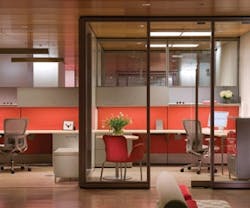You're enclosing a space for a new conference area. But what if you need to turn that enclosed conference room into an open informal collaborative area or workspaces to accommodate an influx of employees?
Tearing down the existing walls enclosing the space is a costly, time-consuming, and messy job. That is, unless you opted to use demountable or mobile partitions.
Movable vs. Demountable
There are two fundamental types of non-permanent partitions: movable and demountable.
"A more traditional operable partition would be the type that is supported from the ceiling and pulls out from the wall in sort of an accordion fashion," says Mike Reinhart, interior design project manager for Perkins + Will. "You can also do the type that are recessed in a ceiling – they're motorized and retract downward."
Demountable partitions, on the other hand, are essentially walls that can be removed in sections. "Demountable partitions are individual wall panels that can be removed and reinstalled and usually connect to a ceiling grid and to the floor," Reinhart explains.
Flexibility Is Fundamental
Flexibility is one reason to opt for demountable partitions. Your need for flexibility will dictate whether demountable partitions are suited for your needs and your facility.
Demountable partitions are relatively easy to install during or after construction, and can be taken down and reinstalled by your facilities crew or a service provider in a matter of hours.
Over a night or a weekend, demountable partitions enclosing a conference area can be removed so the area can be turned into desked workspace for new employees. The same partitions can then be reinstalled in another area, providing a new enclosed office or conference area.
"A movable wall product will allow a customer to change their culture and their environment without having to go through a whole construction process," says Rob Wittl, senior project manager for KI Movable Walls. "We have a lot of customers that say, 'We need to do this change at night or over the weekend,' and having a flexible product allows them to make these changes quickly, efficiently, and cost-effectively."
Because these systems do have a higher upfront cost than constructed walls, you must consider if you will actually take advantage of the mobility of the partitions. "The end user really has to weigh whether or not they have significant movement and churn so that they're truly going to reuse the product," Whittl says.
The real savings in demountable walls lies in the long-haul usage of the walls. If you set them up and never move them so they act as permanent walls, you won't see a cost savings at all.
However, "If there's a lot of churn and you're tearing down rooms of demountable partitions, which would otherwise be built space, and redeploying them elsewhere, it'll pay off down the road," Reinhart explains.
Acoustic Concerns
Acoustic properties are always a concern when it comes to walls –
whether permanent, movable, or demountable. Acoustics are just one more consideration to make when deciding between wall types.
Acoustic value in demountable partitions is measured by STC (sound transmission class), a measurement of how well the wall will block sound from one room to another.
Demountable partitions have an STC that might range between the mid-30s to the mid-40s, explains Reinhart, while a permanent drywall would range between low 40s and upper 50s.
Code Conscious
Codes are another factor to consider before installing demountable partitions. "When you have built environments and you have lighting within the rooms, if you take that room apart or create a new room with demountable partitions, you still need to make sure that you have lighting configurations and HVAC distribution working in the room," Reinhart says.
There are plenty of variables to consider before installing demountable partitions. Consider your company's churn rate and culture, acoustic concerns, your city codes, and whether you'll benefit from walls that can move.
Kylie Wroblaski ([email protected]) is associate editor of BUILDINGS.
